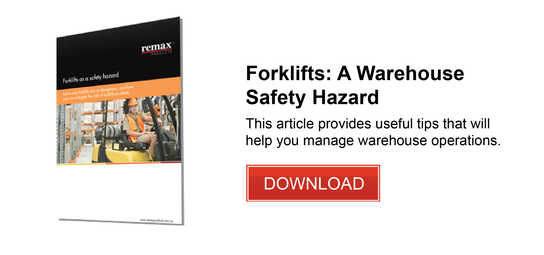What Can Warehouse Maintenance Managers Do to prevent forklift accidents in the warehouse?

Three things that you can do to help to prevent forklift accidents in your warehouse
While forklifts are needed to ensure efficient warehouse operations, they are heavy-duty pieces of equipment that can inflict serious damage to those around them.
How serious? Tragic news stories from the past week remind us just how dangerous forklifts can be:
- A 27 year old man was killed in an accident while operating a forklift at the brewery when the vehicle overturned. He was pinned under a forklift at the business this weekend.
(Source: UT San Diego) - A toddler was killed at a farm when a forklift loader was backing up.
(Source: NBC) - A man was killed in an accident at a metal shop. A large stacked bale of copper wire fell on the employee when he got off the forklift. The victim was vice president and co-owner of the company.
(Source: WRAL) - A Tasmanian court awarded a man left quadriplegic after a forklift accident a record payout of $5.5 million in damages. The 65 year old suffered catastrophic and permanent injuries when he was struck by several packages of laminate flooring which fell from a forklift
(Source: ABC).
Since collisions are all too common, managers must put the necessary measures in place to prevent them. Beyond regular training, you must consider the design, equipment, and processes of your warehouse.
Here's three things that you can do:
1. Consider the Warehouse Environment
.jpg?width=229&name=Traffic%20Lights%20(Medium).jpg) In terms of your environment, you should try to improve visibility. Forklift operators must be able to have the most visibility possible so that they know what's in their path. A poorly lit warehouse will automatically make it more prone to accidents.
In terms of your environment, you should try to improve visibility. Forklift operators must be able to have the most visibility possible so that they know what's in their path. A poorly lit warehouse will automatically make it more prone to accidents.
Doors that allow easy access and good visibility while controlling the environment can help with this. With Rapid Roller Doors, safety features such as integrated traffic lights which show when there is traffic or pedestrians on the other side of the door, will be very useful for busy forklift operators who are working quickly to get goods where they need to be.
2. Manage Traffic With Aisles & Islands

Pedestrian and industrial traffic can be separated with traffic islands and traffic aisles.
In terms of traffic aisles, tape markings can be used, but are easier to ignore. It's much better to install steel barriers such as guard rails so that there's no chance of forklifts and pedestrians stepping over the line.
In terms of traffic islands, you can have barriers around work stations, assembly points, in-plant offices, and other pedestrian areas. Steel guard rails can ensure that forklift-personnel collisions do not occur. Place them around your packing station, computer terminal, assembly station, and pick-point.
3. Reduce Costs Incurred by Damage
In an accident, your facilities, equipment, and inventory are also at stake. To reduce your costs in this respect, use material handling equipment, such as bollards and guard rails.
Polyethylene bollards will protect a limited amount of space, so you can place them around your dock doors and other equipment. Guard rails can protect your pallet racks by being a barrier against forklifts.
There are also indirect costs that can be incurred by forklift accidents. For example, if your roller doors have been hit by a forklift, they can't operate until they have been fixed. You will lose money due to production loss. Also, since they aren't sealing properly, you'll have to pay for increased cleaning to prevent external contamination. This is in addition to the cost of fixing the damaged roller doors.
In this scenario, you would be better off investing in high speed roller doors that adjust in a collision. For example, our rapid roller doors have a crash relocation system which re-inserts the curtain automatically after accidental impact.
For more information on this topic, please download our complimentary article:







